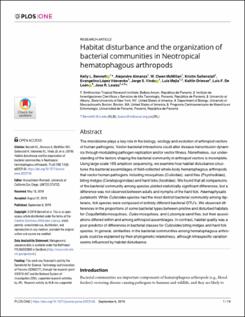Habitat disturbance and the organization of bacterial communities in Neotropical hematophagous arthropods

View/
Date
2019-09-06Author
Bennett, Kelly L.
Almanza, Alejandro
McMillan, W. Owen
Saltonstall, Kristin
Vdovenko, Evangelina Lopez
Vinda, Jorge S.
Mejia, Luis
Driesse, Kaitlin
De Leon, Luis F.
Loaiza, Jose R.
Metadata
Show full item recordAbstract
The microbiome plays a key role in the biology, ecology and evolution of arthropod vectors of human pathogens. Vector-bacterial interactions could alter disease transmission dynamics through modulating pathogen replication and/or vector fitness. Nonetheless, our understanding of the factors shaping the bacterial community in arthropod vectors is incomplete. Using large-scale 16S amplicon sequencing, we examine how habitat disturbance structures the bacterial assemblages of field-collected whole-body hematophagous arthropods that vector human pathogens including mosquitoes (Culicidae), sand flies (Psychodidae), biting midges (Ceratopogonidae) and hard ticks (Ixodidae). We found that all comparisons of the bacterial community among species yielded statistically significant differences, but a difference was not observed between adults and nymphs of the hard tick, Haemaphysalis juxtakochi. While Culicoides species had the most distinct bacterial community among dipterans, tick species were composed of entirely different bacterial OTU’s. We observed differences in the proportions of some bacterial types between pristine and disturbed habitats for Coquillettidia mosquitoes, Culex mosquitoes, and Lutzomyia sand flies, but their associations differed within and among arthropod assemblages. In contrast, habitat quality was a poor predictor of differences in bacterial classes for Culicoides biting midges and hard tick species. In general, similarities in the bacterial communities among hematophagous arthropods could be explained by their phylogenetic relatedness, although intraspecific variation seems influenced by habitat disturbance.
